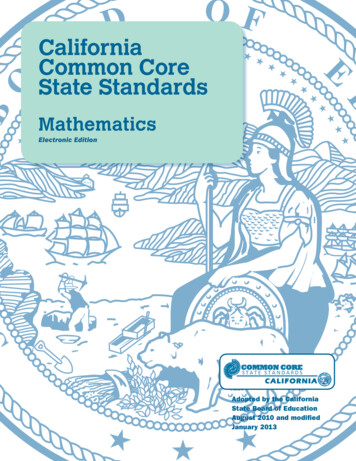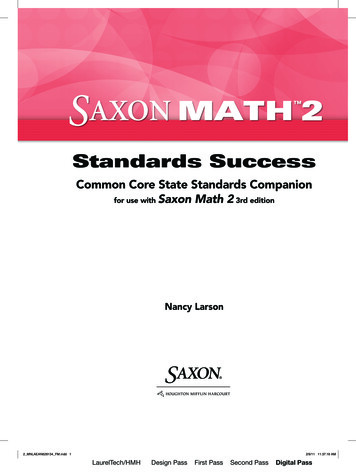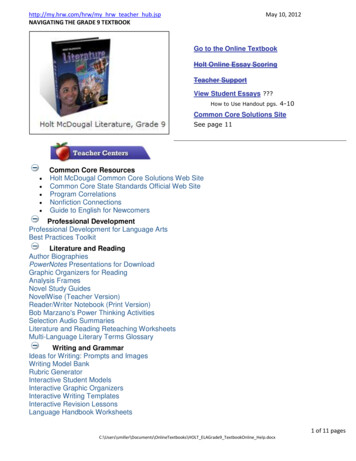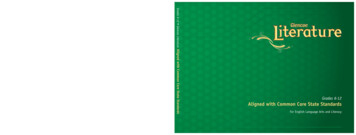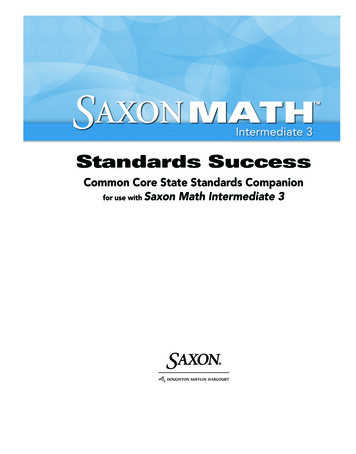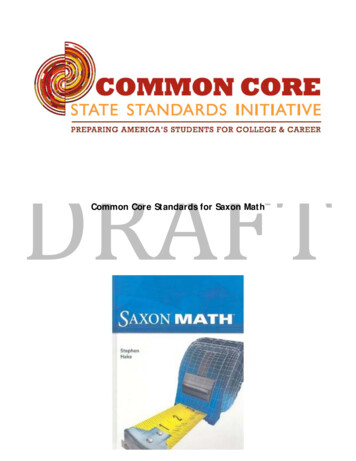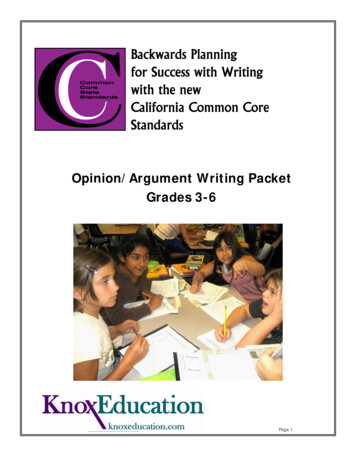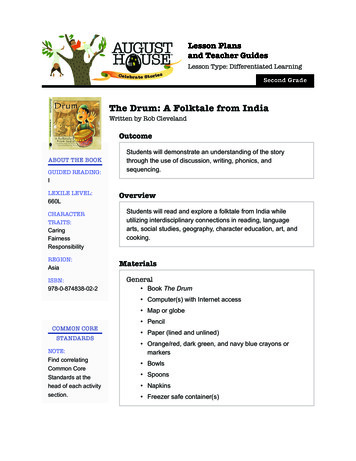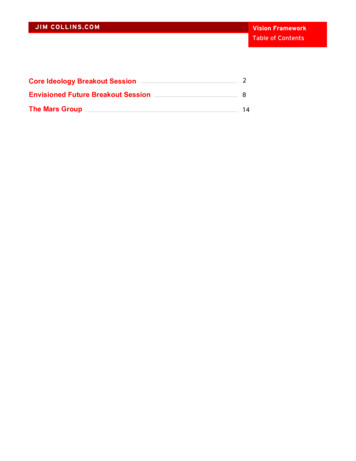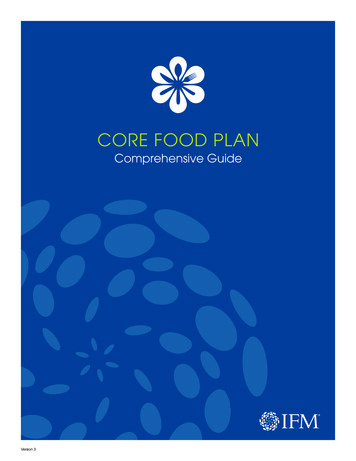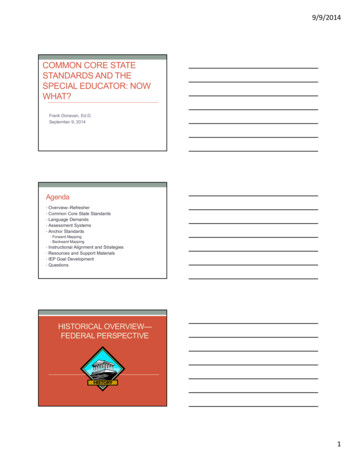
Transcription
9/9/2014COMMON CORE STATESTANDARDS AND THESPECIAL EDUCATOR: NOWWHAT?Frank Donavan, Ed.D.September 9, 2014Agenda Overview--Refresher Common Core State Standards Language Demands Assessment Systems Anchor Standards Forward Mapping Backward Mapping Instructional Alignment and Strategies Resources and Support Materials IEP Goal Development QuestionsHISTORICAL OVERVIEW—FEDERAL PERSPECTIVE1
9/9/2014History of Special Education 1975: PL 94-142—EAHCA Child Find FAPE for All Students LRE 1977: CA Master Plan SELPAs Fiscal, Procedural, Compliance, Programs 1980s: ? Lack of Consistency Random Acts of Greatness Case LawHistory of Special Education (cont.) 1990s: FAPE & LRE Case Law 1997: IDEA Reauthorized Access to Gen. Ed. Curriculum Increase in Litigation 1998: CA Content Standards CSTs, API 2001: NCLB Subgroups Accountability Increase in LitigationHistory of Special Education (cont.) 2003: CAPA Accountability for Mod to Severe 2004: IDEA Reauthorized Greater Emphasis on Core Curriculum and Access to Typical Peers Research-Based Practices 2007: CMA 2010: OSEP—Focus on Outcomes 2014: Results Driven Accountability (RDA) 2014-15: CCSS2
9/9/2014Progression of Guidance and Structurefor Standards-Instructionally BasedIEPsLack of dardsInstructionallyBasedResults Driven Accountability (RDA) U.S. Department of Education Education Secretary Arne Duncan stated that “States have gotten better atmeeting the IDEA’s procedural requirements, such as promptly evaluatingstudents suspected of having a disability however, ‘we unfortunatelyhave not seen a corresponding improvement in student results.’” Office of Special Education Programs (OSEP) RDA Could/May Consist of: Test Scores Test Participation Rates Post-School Outcomes Suspension/Expulsion One or More of the AboveCalifornia “Needs Intervention”The IDEA requires the U.S. Department of Education to placeStates into four categories regarding their performance underthe IDEA. Those categories are as follows:1. Meet Requirements (15 States and 2 U.S. Territories wereplaced into this category)2. Need Assistance (32 States and 4 U.S. Territories were placedinto this category)3. Need Intervention (3 States—including CA—and 3 U.S.Territories were placed into this category)4. Need Substantial Intervention (No States or U.S. Territorieswere placed into this category)3
9/9/2014COMMON CORE STATESTANDARDSCCSS Themes College and Career Readiness (CCR) 21st Century Learning Learning and Innovation Skills Life and Career Skills Information Media and Technology Skills 4-Cs— Critical Thinking Communication Collaboration CreativityAre the CCSS for ELA Similar to our CurrentStandards? Existing ELA: Four Categories Called Domains Reading Writing Listening and Speaking Written and Oral English-Language Conventions CCSS ELA: Four Categories Called Strands Reading Writing Speaking and Listening Languagehttp://www.scoe.net/castandards/4
9/9/2014Literacy Across the Content Areas Standards for Literacy in History/Social Studies, Science,and Technical Subjects are embedded in the Readingand Writing Standards at each Grade Level, K-5. Grades 6-8, 9-10, and 11-12, Include Reading Standardsfor Science and Technical Subjects, and WritingStandards for History/Social Studies, Science, andTechnical Subjects.ELA/Literacy Shifts in Focus Content-Rich Nonfiction Informational Text Evidence from Text Reading for Information Complex Text with Academic Language Linkages to Content Knowledge5
9/9/2014Are the CCSS for Math Similar to our CurrentStandards? Shift in Grade Level for some Skills Organization is Different Grade Level Standards K-8 Set of Standards for Algebra 1 Conceptual Cluster Standards for 9-12 Two Options for 8th Grade Algebra 1 Option for those Not Ready for Algebrahttp://www.scoe.net/castandards/Mathematics Shifts in Focus Focus Narrowing Strongly on Focus of Standards Coherence Building Upon Each Grade Level and Linking toMajor Topics Rigor Building Conceptual Understanding, ProceduralSkills, and Focus on Application6
9/9/20147
9/9/2014LANGUAGE DEMANDSLanguage Demands of CCSS for ELA Vocabulary Acquisition and Use Conversational Discourse Narration Not to Mention: Phonological Awareness Fluency Articulation Decoding And So Much More .Role of the SLP Instrumental Identify and Address Foundation Skill Deficits Critical Needs Areas Gaps Preparatory/Foundational Skill Areas Pragmatics Shift from Speech Services to Support Academics toSpeech Services as Support and Integral Part ofAcademics8
9/9/2014Collaboration General Education Special Education All Education Tools to Interpret/Adapt CCSS and SBAC Trainings forStudents with Special Needs CCCS Goal and Instructional Alignment Tool CCSS Goal and Instructional Strategies FrameworkASSESSMENT SYSTEMSThe SBAC Assessment SystemEnglish Language Arts and Mathematics, Grades 3 – 8 and High SchoolLast 12 weeks of year*DIGITAL CLEARINGHOUSE of formative tools, processes and exemplars; released items and tasks;model curriculum units; educator training; professional development tools and resources; aninteractive reporting system; scorer training modules; and teacher collaboration tools.INTERIM ASSESSMENTComputer AdaptiveAssessment andPerformance TasksINTERIM ASSESSMENTComputer AdaptiveAssessment andPerformance TasksScope, sequence, number, and timing of interimassessments locally determinedPERFORMANCETASKS Reading Writing MathCOMPUTERADAPTIVEASSESSMENTRe‐take optionOptional Interimassessment system —no stakesSummative assessmentfor accountability* Time windows may be adjusted based on results from the research agenda and final implementation decisions.Developed by The Center for K–12 Assessment & Performance Management at ETS, version 4, July 2011. For detailed information on PARCC, go tohttp://PARCConline.org.9
9/9/2014SBAC Readiness/Preparation: Areas toConsider Keyboarding Cursive—Really? Screen Navigation Movement of Objects/Items within System Accessibility and Accommodations Computer Adaptive—When Will It BeActivated?CAPA and the National Center and StateCollaborative (NCSC) Overview –Alternate Assessment AB 484 (Bonilla): Law for State Testing—RequiresCAPA AB 2057 (Bonilla): Law to Eliminate Double-Testingor NCSC Pilot Districts—All About Equity Alternate Assessment (e.g., CAPA) for 2014-15 IsStill Undetermined by CDEThe NCSCAlternate Assessment System*English Language Arts and Mathematics, Grades 3–8 and High SchoolDIGITAL LIBRARY of curriculum, instruction, and classroom assessment resources; online professional developmentmodules and support materials for state-level educator Communities of Practice to support teachers with theresources they need to improve student outcomes; guidelines for IEP teams to use in student participation decisionmaking; training modules for assessment administration and interpretation of results; online assessment delivery,administration, and reporting.END-OF-YEARASSESSMENTCOMMUNITIES OF PRACTICE established in each state to support teacher trainingand use of the curriculum, instruction, and assessment resources. Resources will beavailable for use in all schools and districts, as locally determined.Curriculum, instruction,and formativeassessment resourcesfor classroom useInterim progressmonitoring toolsSummative assessmentfor accountability* Alternate assessment systems are those developed for students with the most significant cognitive disabilitiesand are based on alternate achievement standards.10
9/9/2014Alternate Assessment National Center and State Collaborative (NCSC) Dynamic Learning Maps (DLM) Several Other Options Building solid content foundations with articulatededucational logic (Learning Maps; LearningProgressions and CCSS Dual Alignment); andEvidence Centered Design Computer-based delivery of assessments Resources and professional development supports toeducators Opportunity to Share Resources with Other States andAvoid Duplication of EffortLEARNING MAPS VERSUSLEARNING PROGRESSIONSProgressions Vertical progressiontoward learning target Sequenced buildingblocks Research-based Linked to high-qualityassessments11
9/9/2014Uses percentages tomake straightforwardcomparisonsUses the symbols , and to ordernumbers and makecomparisonsUses decimalnotation to two placesUses place value todistinguish and orderwhole numbersUse numbers todecide which isbigger, smaller, samesizeMasters, G. & Forster, M. (1997). Developmental Assessment.Victoria, AU: The Australian Council for Education Research Ltd.Maps Allow for the Integration ofMultiple Skills EqualquantityCompare twoquantities up toten usingmodelsIdentifymorenumber ofIdentifysamenumber ofUseperceptualsubitizingIdentifyfewernumber ofIdentify morethan oneIdentifydifferentnumber ofIdentify oneComparesetsExplain ntCompareobjectsImitateCreate a modelof quantity12
9/9/2014ANCHOR STANDARDSCCSS Anchor Standards Anchor Standards—Progress Through Multiple Grade Levels Skills Build Upon Prior Grade Levels ommon-core-state-standards-and-assessments fReading Standards for Literacy in Science andTechnical Subjects (RST): Standard 2RST.2Anchor Standard: Determine central ideas orthemes of a text and analyze their development;summarize the key supporting details and ideas. RST.2.11-12Grade 11-12studentsDetermine the central ideas or conclusions of a text;summarize complex concepts, processes, or informationpresented in a text by paraphrasing them in simpler but stillaccurate terms. RST.2.9-10Grade 9-10studentsDetermine the central ideas or conclusions of a text; tracethe text’s explanation or depiction of a complex process,phenomenon, or concept; provide an accurate summary ofthe text. RST.2.6-8Grade 8studentsDetermine the central ideas or conclusions of a text; providean accurate summary of the text distinct from prior knowledge or opinions.13
9/9/2014Reading Standards for Literacy in Science and TechnicalSubjects (RST): Standard 1RST.1Anchor Standard: Read closely to determine what the textsays explicitly and to make logical inferences from it; citespecific textual evidence when writing or speaking to supportconclusions drawn from the text. RST.1.11-12Grade 11-12studentsCite specific textual evidence to support analysis of science andtechnical texts, attending to important distinctions the author makes and to any gaps or inconsistencies in the account.RST.1.9-10Grade 9-10studentsCite specific textual evidence to support analysis of science andtechnical texts, attending to the precise details of explanations or descriptions.RST.1.6-8Grade 8studentsCite specific textual evidence to support analysis of science and technical texts.Key Ideas and Details: Standard 16, [7], 8 Cite [several pieces of] textual evidence that most strongly supportanalysis of what the text says explicitly as well asinferences drawn from the text.4, [5] [Quote accurately and] refer to details and examples in a text whenexplaining what the text says explicitly and whendrawing inferences from the text.1, [2], 3 Ask and answer questions [such as who, what, where, when, whyand how to demonstrate understanding] about keydetails in a text, referring explicitly to the text as the basis for the answers.K With prompting and support, ask and answer questions about key detailsin a text.Grade—StandardCCR Anchor Standard 1: Read closely to determine what the text saysexplicitly and to make logical inferences fromit; cite specific textual evidence when writing or speaking to supportconclusions drawn from the text.Inform Instructional Planning andImplementationForward Mapping Foundational SkillsBackward Mapping Compare Grade-level Concepts in PrintStandards to Language Phonological Awareness and Phonics and WordCommunication ProfileReading Provide Tier-based FluencyInstruction in Known or Comprehension andVocabulary Development Projected Areas of Need CCSS Anchor Standards14
9/9/2014RESOURCES ANDSUPPORT MATERIALSNational Center and State Collaborative Instructional Resources Aligned to the CCSS Curriculum Resources Classroom Solutions Main PageResources on the Wiki Link15
9/9/2014Core Content Connectors (CCC):Reading for Informational TextElement Cards: Reading for InformationalTextInstructional Resources Curriculum Resource Guide Instructional Units Graduated Understandings Instructional Resource Guide Scripted Systematic Instruction Element Cards16
9/9/2014Curriculum Resources Explain How to Teach Students Including thosewith Significant Disabilities Based on Universal Design for LearningStrategies Provide ExamplesClassroom Solutions Instructional Units UDL Strategies Multiple Means of Engagement, Representation andExpression General Education Lessons Designed to be Accessible to Students with Significant CognitiveDisabilities Promote Inclusive and Collaborative StrategiesProgress Indicator: E.NO.1aCore ContentConnectors: Kshowing mastery of the prerequisite core skills of cardinality, constancy, and 1:1 correspondenceCCSS Domain/ClusterCounting and CardinalityK.NO.1a1 Rote count up to 10 K CC Know number names andthe count sequence.Counting and CardinalityK.NO.1a2 Rote count up to 31 K CC Know number names andthe count sequence.K.NO.1a3 Rote count up toCounting and Cardinality100K CC Know number names andthe count sequence.K.NO.1a4 Count up to 10Counting and Cardinalityobjects in a line, rectangle, or K CC Count to tell the number ofarrayobjects.Common Core State StandardK.CC.1 Count to 100 by ones and by tens.K.CC.1 Count to 100 by ones and by tens.K.CC.1 Count to 100 by ones and by tens.K.CC.4 Understand the relationship between numbers and quantities; connect countingto cardinality.a)When counting objects, say the number names in the standard order, pairingeach object with one and only one number name and each number name withtone and only one object.K.CC.5 Count to answer “how many?” questions about as many as 20 things arranged ina line, a rectangular array, or a circle, or as many as 10 things in a scatteredconfiguration; given a number from 1‐20, count out that many objects.Progress Indicator: E.NO.1b developing an understanding of number and principles of quantity (e.g., hold up 5 fingers at once to show 5, locatethings in 2s without counting; using number words to indicate small exact numbers or relative change in quantity ‐ more, small)Core Content Connectors: KCCSS Domain/ClusterCommon Core State StandardK.NO.1b1 Match the numeralCounting and CardinalityK.CC.4 Understand the relationship between numbers and quantities; connect countingto the number of objects in a K CC Count to tell the number of to cardinality.a)When counting objects, say the number names in the standard order, pairingsetobjects.each object with one and only one number name and each number name withtone and only one object.K.CC.5 Count to answer “how many?” questions about as many as 20 things arranged ina line, a rectangular array, or a circle, or as many as 10 things in a scatteredconfiguration; given a number from 1‐20, count out that many objects.K.CC.4 Understand the relationship between numbers and quantities; connect countingK.NO.1b2 Identify the set thatCounting and Cardinalityhas moreK CC Count to tell the number of to cardinality.objects.a)Understand that the last number name said tells the number of objects counted.The number of objects is the same regardless of their arrangement or the orderin which they were counted.17
9/9/2014College and Career Readiness Anchor Standards for ReadingKey Ideas and Details1. Read closely to determine what the text says explicitly and to make logical inferences from it; citespecifictextual evidence when writing or speaking to support conclusions drawn from the text.2. Determine central ideas or themes of a text and analyze their development; summarize the keysupportingdetails and ideas.3. Analyze how and why individuals, events, and ideas develop and interact over the course of a text.Reading Standards for LiteratureGrade 3 students:1. Ask and answer questions todemonstrate understanding of a text,referring explicitly to the text as thebasis for the answers.Grade 4 students:1. Refer to details and examples in atext when explaining what the text saysexplicitly and when drawing inferencesfrom the text.Grade 5 students:1. Quote accurately from a text whenexplaining what the text says explicitlyand when drawing inferences from thetext.CCCs3.RL.h1 Answer questions related tothe relationship between characters ,setting, events, or conflicts (e.g.,characters and events, characters andconflicts, setting and conflicts).CCCs4.RL.i1 Refer to details and examplesin a text when explaining what the textsays explicitly.CCCs5.RL.b1 Refer to details and examplesin a text when explaining what the textsays explicitly.3.RL.i2 Answer questions (literal andinferential) and refer to text to supportyour answer.4.RL.i2 Refer to details and examplesin a text when drawing basic inferencesabout a story, poem, or drama.5.RL.b2 Refer to specific text evidenceto support inferences, interpretations,or conclusions.3.RL.i3 Support inferences, opinions,and conclusions using evidence fromthe text including illustrations.4.RL.k1 Use details and examples in atext when explaining the author’spurpose (e.g., what did the author useto scare you, surprise you?).Sample Script (Model, Lead, Test)What is included in IR Guide? Overview of Systematic Instruction Importance of Finding a Response Mode Explanation of Instructional Strategies and “how to” Provides sample script for math and ELA skill for eachinstructional strategy Troubleshooting Q&A Constant Time Delay (CTD) System of Least Prompts (LIP) Model, Lead, Test Example/Non-example Training18
9/9/2014InstructionalResource GuideStruggling Readers Late-emerging Poor Readers (13.4% of the Population)—were Average or Better in Earlier Grades Comprehension Alone (52%) Word Reading Alone (36%) Both of the Above (12%) Often had a History of Language and/or Nonverbal CognitiveImpairments in Kindergarten No Clear Predictive ProfileCatts, H.W., Compton, D., Tomblin, J.B., & Bridges, M.S., (2012)Prevalence and Nature of Late-emerging Poor Readers. Journal ofEducational Psychology, 104, 166-181.19
9/9/2014The Core Six: Essential Strategies for AchievingExcellence with the Common Core (Silver, Dewing, &Perini, 2012) Reading for Meaning Compare and Contrast Inductive Learning Circle of Knowledge Write to Learn Vocabulary’s CodeReading for Meaning Previewing and Predicting Before Reading Actively Searching for Relevant Information DuringReading Reflecting on Learning After Reading Avoid: Reading Entire Passage Without Doing the Above Expecting Gains in Comprehension Without Front-Loading andProviding Explicit Direct Instruction20
9/9/2014Teaching the Critical Vocabulary of theCommon Core (Sprenger, 2013) Critical Vocabulary: The Verbs Analyze Articulate Cite Compare/Contrast Draw Identify Infer Locate Retell Support(This is 10 of the 30 Verbs)Teaching the Critical Vocabulary of the CommonCore (Sprenger, 2013)—Continued . Critical Vocabulary: The Nouns Analogy Argument Central Idea/Main Idea Conclusions Connections Evidence Point of View Structure Theme Tone and Mood(This is 10 of the 20 Nouns)Teaching the Critical Vocabulary of the CommonCore (Sprenger, 2013)—Continued . Critical Vocabulary: The Last Words Classify/Categorize Explicitly Recognize Recount21
9/9/2014Connecting Teachers, Students and Standards(Voltz, Sims, Nelson, 2010) Inclusive Practices Access to General Ed. Curriculum Opportunities for Socially Appropriate Behaviors Preparing Students with and without Disabilities for theReal World22
9/9/2014Common Core and the Special EducationStudent (Schillinger and Wetzel, 2014) Very Comprehensive and Informative Shifts in CCSS Instructional Practices Technology Integration CCSS Standards-Based IEPs CCSS Standards-Based IEP Goals And Much More .HOW CAN WE TIE ALL OFTHIS TOGETHER?What are Other States Doing to AssistStudents with Mild, Moderate and SevereNeeds? Universal Design for Learning (UDL) Core Content Connectors Content Modules Curriculum Resource Guides Instructional Resource Guides LASSIS MASSIS Element Cards23
9/9/2014CareerCollegeCommunityCurriculumCommon CoreStandardsLearning ProgressionsCore ContentConnectorsInstructionGrade-level LessonsAccommodationsSystematic InstructionAssessmentFormative, InterimSummativeCommunicative CompetenceUDL Strategies for Instruction Strategies and lessons are taken from the generaleducation curriculum. Principles of UDL are applied: Multiple Means of Engagement give learnersvarious ways of acquiring information andknowledge.Multiple Means of Representation give learnersoptions for expressive skills and fluency.Multiple Means of Expression provide learnersalternatives for demonstrating what they know andprovide options for recruiting interest, sustainingeffort, and self regulation.UDL Strategies (cont.) All strategies/lessons are modified and oradapted for Emerging Readers and EmergingCommunicators:Additional Considerations for Emerging Readers andCommunicators Multiple Means of Engagement: Show the end first;present the concrete example of the graph; with the endin mind, have students at multiple levels solve in multipleways; count or solve using a calculator, graph paper, 2and 3 dimensional manipulative materials Multiple Representation: 2 dimensional paper; 3dimensional objects; etc. Multiple Means of Expression: Picture problemchoices: present 2 choices of possible correct responsesand include words or pictures, tactile representations24
9/9/2014Universal Design for Learning UDL is a Set of Principles that Provides All StudentsEqual Opportunities to Learn Recognition Networks: The “What” of Learning Strategic Networks: The “How” of Learning Affective Networks: The “Why” of LearningDepth of Knowledge Level 1 Recall & Reproductions Specific Facts, Definitions, Routine Procedures Level 2 Skills & Concepts Applying Skills and Concepts, Relationships, Main Ideas Level 3 Strategic Reasoning Reasoning and Planning in Order to Respond Level 4 Extended Reasoning Complex Planning and Thinking—Usually Over a Period of TimeDepth of Knowledge (DOK)Level 1—Recall and ReproductionTeacherStudent Directs Responds Shows Remembers Questions Memorizes Demonstrates Explains Compares Restates Examines Interprets Tells Recognizes Evaluates Translates25
9/9/2014Depth of Knowledge (DOK)Level 2—Skills and ConceptsTeacherStudent Shows Solves Problems Observes Calculates Facilitates Completes Questions Constructs Organizes Demonstrates Evaluates CompilesDepth of Knowledge (DOK)Level 3—Strategic ReasoningTeacherStudent Probes Discusses Clarifies Debates Guides Examines Organizes Judges Dissects Justifies Questons Uncovers Accepts Disputes Acts a Resource DecidesDepth of Knowledge (DOK)Level 4—Extended ReasoningTeacherStudent Facilitates Designs Reflects Takes Risks Extends Proposes Analyzes Formulates Evaluates Plans Creates Modifies26
9/9/2014Depth of Knowledge--Activities Level 1 Recall & Reproductions Concept Map, Timeline, Keywords, Chart, Recite Facts, Cut Out, Draw,Cartoon Strip, Oral Report, Outline, Paraphrase, Retell Level 2 Skills & Concepts Classify a Series of Steps, Construct a Model—Demonstrate How itWorks, Perform a Play, Make a Game or Puzzle About the Area of Study,Explain the Meaning of a Concept, Explain Relationship Among a Numberof Concepts, Multi-Step Calculations Level 3 Strategic Reasoning Venn Diagram to Show how Two Topics are the Same and Different,Design a Questionnaire, Flow Chart to Show Stages, Conduct anInvestigation, Debate, Persuasive Speech, Letter with Point of View,Research and Report on the “Why” of an Issue or Topic Level 4 Extended Reasoning Formulate and Test Hypotheses, Perspective Taking and Collaboration,Persuasive Writing Tasks, Devise a Way To , Sell and Idea, Write aJingle to Sell an Idea, Develop a Menu with a Variety of Healthy FoodsThe Least Dangerous AssumptionWe assume that students with the most significant cognitivedisabilities are competent and able to learn, and wesupport increased educational opportunities in a range oflearning environments.80DEVELOPING IEP GOALSBASED ON THE CCSS27
9/9/2014Developing Goals Based on the CCSSDeveloping Instructionally AppropriateIEPs? An Instructionally Appropriate IEP describes a process inwhich the IEP team has incorporated state contentstandards in its development Specific accommodations and modifications addressingstudent’s needs to access the general educationinstructional program are included in the InstructionallyAppropriate IEP for student’s present grade-level andcourse content requirements.Current Practice IEP Team Identifies Unique Needs Unique Needs Are Often Discussed Without Reference toGrade-Level Standards, Curriculum and Instruction This Often Results in Two Parallel Educational and/orInstructional Programs for Students with IEPs General Education and Special EducationOr, Functional and Academic28
9/9/2014Best Practice Identify Student’s Unique Needs in Relation to the CCSS Develop Present Levels Based on Unique Needs andCCSS Identify the Gap Between PLOP and Grade-Level CCSS Develop a Plan to Meet—or Get As Close As Possible to--Grade-Level CCSS Develop Annual IEP Goals Based on All of the AboveDeveloping Goals Based on the CCSS Use Grade-Level Standards Examine the Essential Content and Skills within thatStandard Based on the Student’s Identified Unique Needs Unpack the Standard Aim High--Rigor and Fidelity based on Bloom Webb’s Depth of Knowledge Universal Design for Learning Work Towards Closing Gaps Grade-Level Access with Supplemental Remediation OnlyAs Needed Reminder: the Entire Standard Is Not the GoalConsider All Areas Environmental Situations Social Interactions Behavioral Needs Prerequisite Skills Curriculum Resources Instructional Resources Instructional Methodologies Accommodations and/or Modification Assessment Procedures Progress Reporting29
9/9/2014Access to the General EducationCurriculum An IEP must include “a statement of measurable annualgoals, including academic and functional goals, designedto meet the child’s needs that result from the child’sdisability to enable the child to be involved in and makeprogress in the general education curriculum.”(IDEA, 2004, 614(d)(1)(A)(i),)Developing Goals and Objectives Based on theCCSS and Specially Designed InstructionIEP GoalUnpacking the Standards, or Putting the“I” in CCSS The “I” is Instruction Individualizing Grade-Level Standards Select the Standard Based on Present Levels ofPerformance Assessment Progress on Last Year’s Goals Curriculum-Based Assessment Circle the Verbs and/or Action Words and Terms Underline the Key Skills Develop Goals30
9/9/2014A Quick Word or Two About PresentLevels of Performance PLOPS are Always Directly Related to the Goal Always Include a Strength and Weakness Weakness Goal Avoid TMIExample of PLOP PLOP: Based on scores on the WJ (list reading or spellingscores) and curriculum-based measures (list Curriculumor supplemental materials used—e.g., work samples fromCorrective Reading or Open Court) Frank understands allof his grade-level short vowel CVC words; however, he iseasily distracted during class instruction and is not able toconvert short vowels to long vowels using the magic “e.” Goals: By 9-9-15, Frank will be able to convert 20 shortvowel CVC words to long-vowel CVCV words using themagic “e” with 90% accuracy in 4 out of 5 trials. DiscussionExample of PLOP (continued) PLOP: Based on scores on the WJ (list reading or spellingscores) and curriculum-based measures (list Curriculumor supplemental materials used—e.g., work samples fromCorrective Reading or Open Court) Frank understands allof his grade-level short vowel CVC words; however, he isnot able to convert short vowels to long vowels using themagic “e.” Goals: By 9-9-15, Frank will be able to convert 20 shortvowel CVC words to long-vowel CVCV words using themagic “e” with 90% accuracy in 4 out of 5 trials.31
9/9/2014What is the difference betweenthe Traditional and Instructionally Appropriate IEP?Traditional IEP Focused on acquiring basicacademic, access, and/orfunctional skills Little relationship to aspecific academic area orgrade-level expectationsInstructionally Appropriate IEP Directly tied to the Common Corestandards Both the student’s present level ofacademic achievement andfunctional performance (PLOP) andthe annual IEP goals are alignedwith and based on the state’sgrade-level standardsWhat are the benefits of aInstructionally Appropriate IEP? Ties the IEP to the general education curriculumProvides positive directions and goals for interventionUtilizes standards to identify specific content critical to astudent's successful progress in the general educationcurriculumPromotes a single educational system that is inclusivethrough common language and curriculum for specialand general education studentsEnsures greater consistency across schools anddistrictsEncourages higher expectations for students withdisabilitiesDoes an Instructionally Appropriate IEP imply that thestudent is on grade-level in that content area? No, the student may not be on grade-level in thatcontent area. However, they are working towardmeeting grade-level expectations and
CSTs, API 2001: NCLB Subgroups Accountability Increase in Litigation History of Special Education (cont.) 2003: CAPA Accountability for Mod to Severe 2004: IDEA Reauthorized Greater Emphasis on Core Curriculum and Access to Typical Peers Research
